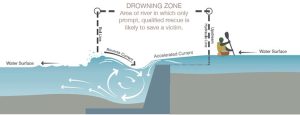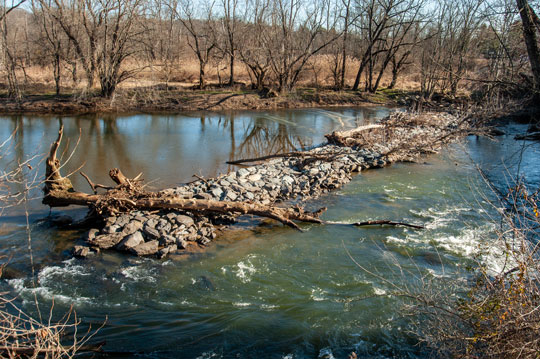The Brandywine Conservancy is looking to take down the Hoffman Mill dam on the Brandywine Creek at Route 1. According to the conservancy’s Director of Community Services Grant DeCosta, removing the dam is a matter of safety, reducing flooding, and maintaining the health of the creek itself.
DeCosta said the dam adds to flooding issues because it creates what he called “an impoundment behind it,” meaning water stands behind that area and doesn’t flow through during heavy rains. “Having that abnormal backup behind [the dam] is creating a higher groundwater level in the surrounding floodplain.” And that, he said, reduces the floodplain’s storage capacity to absorb the excess water during heavy rain. “The floodplain can’t function as well is it would if the dam wasn’t there.”

Working with DeCosta on the project is Rob Daniels, manager of community services. He likened the floodplain to a sponge and said that backup prevents the sponge from drying which causes the flooding.
“When the dam is there,” Daniels said, “that sponge is artificially full of water. When the floodwater comes down, it can’t fill the sponge because the sponge is full.”
Not only does the dam increase the amount of flooding, DeCosta said, but it can also increase the occurrence of flooding because the sponge is already at capacity.
The dam also creates a safety issue for people canoeing or kayaking down the Brandywine. There’s a breach on the west side of the creek by the culvert that runs under the railroad tracks. And there’s a short drop in that area of the breach. While boaters are told not to go through that area, some do for the thrill of paddling through that part where the water is running faster and deeper. Daniels calls it “an attractive nuisance.”
But it can be dangerous. Boaters can get knocked out of their boats and fall into the backwash of a recirculating current that they can’t escape. Some people have drowned in the Brandywine because they got caught in areas of those currents.
Another reason for wanting to remove the dam is ecological concerns. Removing the dam will improve the health of the creek, DeCosta said. Doing so will restore free-flowing sections and reduce sediment that builds up behind the dam. Dams also increase water temperature which has a negative impact on some species of plant and aquatic life.
Daniels added that removing the dam will increase the number of ripples and pools that create a habitat for native mussels and other creatures that filter out water pollutants. “You’re increasing areas for beneficial habitat.”
The idea for removing the dam came about when the conservancy was conducting the water trail feasibility study in 2019. That study centered on improving safety and providing greater passage for the water trail. Daniels said they realized that the portage around the dam could be a problem because it’s a lengthy walk under Route 1. Removing the dam improves the recreational aspect of the creek, he said.
The conservancy has estimated the cost of the project to be slightly more than $300,000, most of which has been secured. But that figure was from a 2019 estimate, so it may need to be recalculated.
So far, almost $268,000 has been secured from the National Fish and Wildlife Foundation, the Pennsylvania Department of Conservation and Natural resources, and the William Penn Foundation. Pennsbury Township has promised to kick in $18,000 and Chadds Ford Township supervisors indicated last month that the township would consider doing the same as part of the 2023 budget.
There’s no set time for the project, but DeCosta said it should only take a couple of weeks once work starts.
Hoffman’s Mill was built in 1864 and DeCosta said the dam was likely built at the same time since its purpose was to channel creek water to power the mill. The mill ceased operations in 1941 and later became the Brandywine River Museum of Art.
About Rich Schwartzman
Rich Schwartzman has been reporting on events in the greater Chadds Ford area since September 2001 when he became the founding editor of The Chadds Ford Post. In April 2009 he became managing editor of ChaddsFordLive. He is also an award-winning photographer.




Comments